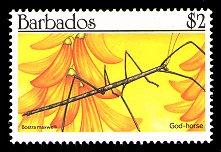Phasmatodea
Pronunciation: [Phas⋅ma⋅TOE⋅de⋅a]
Pronunciation: [Phas⋅ma⋅TOE⋅de⋅a]
Common Name: Walkingsticks / Stick Insects / Leaf Insects / Phasmids
Greek Origins of Name: Phasmatodea, derived from the Greek “phasm” meaning phantom, refers to the cryptic appearance and behavior of these insects.
Hemimetabola, i.e. incomplete metamorphosis (egg, nymph, adult)
Polyneoptera, closely related to Orthoptera and Dermaptera
Common in tropical and subtropical climates where they are found living on their host plants. Approximately 5 families and 32 species in North America and 7 families and >3600 species worldwide.
The leaf and stick insects are sometimes grouped as a family or suborder of Orthoptera. All species are herbivores. As the name “walkingstick” implies, most phasmids are slender, cylindrical, and cryptically colored to resemble the twigs and branches on which they live. Members of the family Timemidae (=Phyllidae) bear a strong resemblance to leaves: abdomens are broad and flat, legs have large lateral extensions, and coloration is primarily brown, green, or yellow. Most walkingsticks are slow-moving insects, a behavior pattern that is consistent with their cryptic lifestyle. In a few tropical species, the adults have well-developed wings, but most phasmids are brachypterous (reduced wings) or secondarily wingless. Stick insects are most abundant in the tropics where some species may be up to 30 cm (12 inches) in length. Females do not have a well-developed ovipositor so they cannot insert their eggs into host plant tissue like most other Orthoptera. Instead, the eggs are dropped singly onto the ground, sometimes from great heights.

In temperate zones, walkingsticks are seldom abundant enough to cause injury to their host plants. In the tropics, however, some species have been known to defoliate forest trees and cause economic losses to shrubbery and shade trees.
Phasmatidae (Walkingsticks) — mimic sticks and twigs
Timemidae (Leaf Insects) — mimic leaves and foliage
 According to West Indian folklore, God often rides from place to place on a walkingstick. As a result, this cryptic insect has come to be known locally as a “God-Horse”. In 1990, the country of Barbados (the easternmost island in the West Indies) issued this stamp that illustrates a native stick insect, Bostra maxwelli.
According to West Indian folklore, God often rides from place to place on a walkingstick. As a result, this cryptic insect has come to be known locally as a “God-Horse”. In 1990, the country of Barbados (the easternmost island in the West Indies) issued this stamp that illustrates a native stick insect, Bostra maxwelli.